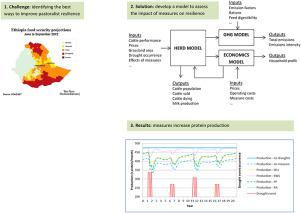Agricultural Systems ( IF 6.6 ) Pub Date : 2023-03-24 , DOI: 10.1016/j.agsy.2023.103636 Michael MacLeod , Ben Henderson , Felix Teillard , Wamalwa Kinyanjui , Fisseha Tadesse , Lee Cando , Clark Halpern , Leah A. Germer , Pierre J. Gerber

|
CONTEXT
Pastoral and agro-pastoral (PAP) systems in East Africa face a range of challenges including increased climate variability. Various measures have been proposed to improve the resilience of pastoral/agro-pastoral (PAP) systems to drought. However, identifying the most effective measure for a given system and location is complicated, and tools are required to appraise measures on a consistent basis.
OBJECTIVE
This paper develops a model of a PAP system and uses it to assess the effects of four measures (Index-based livestock insurance, IBLI; Commercial destocking with an early warning system, EWS; Rangeland restoration, RR; Fodder planting, FP) on the resilience of the PAP system. It also quantifies the greenhouse gas (GHG) effects of the measures, thereby identifying potential trade-offs and synergies between the policy objectives of resilience and climate smart agriculture (CSA).
METHODS
A dynamic model of the Borena pastoral cattle system was developed to undertake the analysis. At its core is a herd model that calculates the changes in cattle population over time. Feed availability and drought occurrence affect fertility and mortality rates, which in turn determine the population and (meat and milk) production. A suite of indicators covering the three dimensions of CSA (increasing productivity, enhancing resilience and reducing GHG emissions) were developed, and used to compare the situation with and without measures.
RESULTS AND CONCLUSIONS
Destocking with an early warning system provides the biggest increases (relative to the no measure situation) in production and profit, due to the way it changes the herd size and structure. It maintains a larger herd than any of the other measures, and a greater proportion of the herd are adult females. Fodder planting and rangeland restoration provide moderate increases in production and profit. Index-based livestock insurance provides a moderate increase in protein production, but has no effect on profit, as it is designed to reduce risk rather than increase productivity or profit, at least in the short term.
All of the measures increase the total emissions relative to the no measure scenario. In terms of the three dimensions of climate-smart agriculture, IBLI leads to some improvements in productivity and resilience but leads to large increases in total emissions, and modest increases in emissions intensity (EI). EWS leads to large increases in productivity and resilience. However, it also leads to large increases in total emissions and a mixed effect on EI. FP and RR improve productivity and increase total emissions, while having little effect on EI or resilience.
SIGNIFICANCE
This paper illustrates the way in which systems dynamic model can be used to appraise measures designed to improve resilience. The result identify potential synergies and tensions between the goals of resilience and climate smart agriculture, and raises the question of whether fully climate-smart goals are viable in these systems.
中文翻译:

调查埃塞俄比亚南部畜牧系统的恢复力和温室气体性能动态
语境
东非的畜牧业和农牧业 (PAP) 系统面临一系列挑战,包括气候变化加剧。已经提出了各种措施来提高牧区/农牧区 (PAP) 系统的抗旱能力。然而,为给定系统和位置确定最有效的措施是复杂的,并且需要工具在一致的基础上评估措施。
客观的
本文开发了一个 PAP 系统模型,并用它来评估四种措施(基于指数的牲畜保险,IBLI;带有预警系统的商业去库存,EWS;牧场恢复,RR;饲料种植,FP)对PAP系统的弹性。它还量化了这些措施的温室气体 (GHG) 影响,从而确定了复原力和气候智能型农业 (CSA) 政策目标之间的潜在权衡和协同作用。
方法
开发了 Borena 牧牛系统的动态模型来进行分析。其核心是一个畜群模型,可以计算牛群数量随时间的变化。饲料供应和干旱发生会影响生育率和死亡率,进而决定人口和(肉类和牛奶)产量。开发了一套涵盖 CSA 三个维度(提高生产力、增强弹性和减少温室气体排放)的指标,并用于比较采取措施和不采取措施的情况。
结果和结论
由于它改变了畜群规模和结构的方式,带有预警系统的去库存提供了最大的生产和利润增长(相对于无测量情况)。它维持的牛群比任何其他措施都大,而且牛群中有更大比例的成年雌性。饲料种植和牧场恢复可适度增加产量和利润。基于指数的牲畜保险适度增加蛋白质产量,但对利润没有影响,因为它旨在降低风险而不是提高生产力或利润,至少在短期内如此。
相对于无措施情景,所有措施都增加了总排放量。就气候智能型农业的三个维度而言,IBLI 导致生产力和恢复力有所提高,但导致总排放量大幅增加,排放强度 (EI) 适度增加。EWS 导致生产力和弹性的大幅提高。然而,它也会导致总排放量大幅增加,并对 EI 产生混合影响。FP 和 RR 提高了生产力并增加了总排放量,同时对 EI 或恢复力几乎没有影响。
意义
本文说明了系统动态模型可用于评估旨在提高弹性的措施的方式。结果确定了复原力目标和气候智能型农业目标之间的潜在协同作用和紧张关系,并提出了完全气候智能型目标在这些系统中是否可行的问题。


























 京公网安备 11010802027423号
京公网安备 11010802027423号